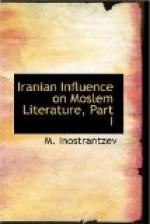[Which stands for Pahlavi and not modern Persian.]
[Sidenote: Zoroaster, Avesta, and Avesta Script.]
Zaradusht brought to the king the book of Avesta, the name of which in Arabic has received a final kaf and has thus become Abestak. The number of chapters of book is twenty one, each chapter comprising 200 leaves. In this book we find a total of sixty vowels and consonants each with a distinct character. Some of these characters are found elsewhere and others have fallen into disseutude. For this script is not confined to the language of the Avesta.
[Sidenote: Extent of Avesta.]
[Sidenote: Persian translation of Avesta.]
[Sidenote: Contents of Avesta.]
Zoroaster invented this writing which the Magians have called Sin Dabireh, that is to say, the ‘sacred writing’. He incised his writing into 12,000 cow skins and filled it with gold. It was in the ancient language of Persia of which no one has any knowledge to-day. Only a few portions of its chapters have been translated into the modern Persian. It is this Persian translation which they have in their hands when, they say their prayers. The translation contains fragments like the Ashtad, the Chitrasht, the Aban Yasht, the Hadukht, and other chapters. In the Chitrasht are found the recitals of the origin and the end of the world. Hadukht comprises exhortations.
[Sidenote: commentaries on Avesta.]
Zoroaster composed the commentary on the Avesta which he called the Zend, and which in the eyes of his followers was revealed to him by God. He subsequently translated it from Pahlavi into Persian. Zoroaster, further, prepared a commentary on the Zend and called it Bazend.
[Sidenote: Their destruction.]
The Mobeds and the Herbeds, learned in the science of religion, commented in their turn on this commentary and their work was called the Barideh, and, by others, the Akradeh. After he had conquered the Persian Empire and put to death Dara son of Dara, Alexander burnt them....
[Sidenote: Synopsis of Zoroastrian beliefs.]




